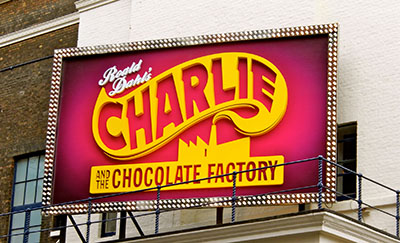 In 2014, Penguin released a 50th-anniversary edition of Roald Dahl’s classic novel Charlie and the Chocolate Factory – to an astonishingly negative reception. Die-hard Dahl fans on Twitter were scathing. They accused the cover of irrelevance and inappropriately sexualisation. Author Patrick Ness described the cover as a publishing mistake as bad as The Hitler Diaries.
In 2014, Penguin released a 50th-anniversary edition of Roald Dahl’s classic novel Charlie and the Chocolate Factory – to an astonishingly negative reception. Die-hard Dahl fans on Twitter were scathing. They accused the cover of irrelevance and inappropriately sexualisation. Author Patrick Ness described the cover as a publishing mistake as bad as The Hitler Diaries.
The cover, which Penguin released via Facebook, features a young wide-eyed girl dressed in pink.
On it went. The Guardian named the cover one of the worst book covers ever. Publishing website The Bookseller reported independent booksellers as saying that the cover was “so postmodern it’s not even relevant to the story” and “totally inappropriate”. They questioned Penguin’s decision to issue separate editions for children and adults.
Judging books by their covers
This negative reaction to a book cover is not without precedent: in 2012 Faber drew flak for reissuing Sylvia Plath’s The Bell Jar with a “chick-lit” cover depicting a woman fixing her make-up.
Plath’s readers took issue with what they saw as the trivialisation of a novel about a woman’s descent into mental illness. By contrast, the backlash against the Charlie and the Chocolate Factory cover seems to stem from the notion of imposing adult themes on what is considered to be a children’s classic.
The cover plays an enormous part in shaping our initial perceptions of a novel.
American author Maureen Johnson provided a fascinating example of this when she challenged her Twitter followers to “coverflip” notable books by changing their covers so as to target either male or female readers.
Publishers target readers of different ages as a matter of course, as the different adult and children’s editions of the Harry Potter series demonstrate.
Authors too value their covers: when his manuscript for The Great Gatsby was delayed, F. Scott Fitzgerald wrote to his editor requesting that a particular cover be reserved for him, saying: “I’ve written it into the book.”
How do you cover a Modern Classic?
Penguin has touched a nerve by issuing a Charlie and the Chocolate Factory cover that has nothing to do with chocolate. One of the few favourable reviews of the cover suggests what is actually significant is Penguin’s decision to include Dahl’s book in its line of Modern Classics. Penguin itself stated:
This design is in recognition of the book’s extraordinary cultural impact and is one of the few children’s books to be featured in the Penguin Modern Classics list.
Compared to the simple orange fill of the regular Penguin Classics, the Modern Classics range regularly uses photography as the medium of choice for covers. Often this is a fairly stark departure from the illustrated original, such as the photograph of two socialites gracing the Modern Classics version of The Great Gatsby, reflecting perhaps on how the novel has come to epitomise the Jazz Age. Jack Kerouac’s On the Road received a nod to its autobiographical roots with a cover photo of Kerouac and his friend Neal Cassady, the inspirations for the characters Sal and Dean.
The Charlie and the Chocolate Factory cover also features a photograph that departs from the aesthetic that governed the book’s original cover – when it was released as a children’s book. Although Penguin has claimed that the girl on the cover is not intended to represent the spoilt child Veruca Salt, there is a notable resemblance in her attire to that worn by Veruca in Quentin Blake’s illustrations for the novel.
But where Blake’s design is caricatured, the Penguin cover is confronting in its realism. It was taken at a fashion shoot, and evokes parallels with the modern-day spectacle of children whose stage parents push them into the limelight.
Books for children and for adults
Penguin obviously believes the book has merit for adults; critics of the cover argue it is fundamentally a book for children. Curiously, an unauthorised biography of Dahl by Jeremy Treglown suggests that Dahl’s editor initially balked at the novel because the fate of the other children was too adult in nature.
This issue has dominated the existing academic commentary on Charlie and the Chocolate Factory, which tends to ask whether or not the book is appropriate for modern sensibilities and curriculums. Jonathon Culley (Children’s Literature in Education, Vol. 22 No. 1 March 1991:pp59-73) examines the concerns that Dahl’s work is too violent, sexist and even racist (consider Wonka’s slurs about his highly racialised workforce) for modern children.
Penguin’s cover was definitely provocative – but if it gets a generation of adults to re-read the book it will be an effective one. Leafing through it again, I found many interesting themes: the ghettoisation of Charlie’s family, Wonka’s harsh response to industrial espionage, and the contrapasso in the children’s fates.
Dahl seemingly anticipates molecular gastronomy and 3D printing – and perhaps the fate of Mike Teavee is more significant in light of reality television. Even as an adult, the irreverent humour, Dahl’s clever rhyming couplets and Blake’s illustrations are still captivating to me.
Ultimately, I think, readers should be talking about the book, not its cover.
This article was originally published on The Conversation. Read the original article.

Rate and Review
Rate this article
Review this article
Log into OpenLearn to leave reviews and join in the conversation.
Article reviews